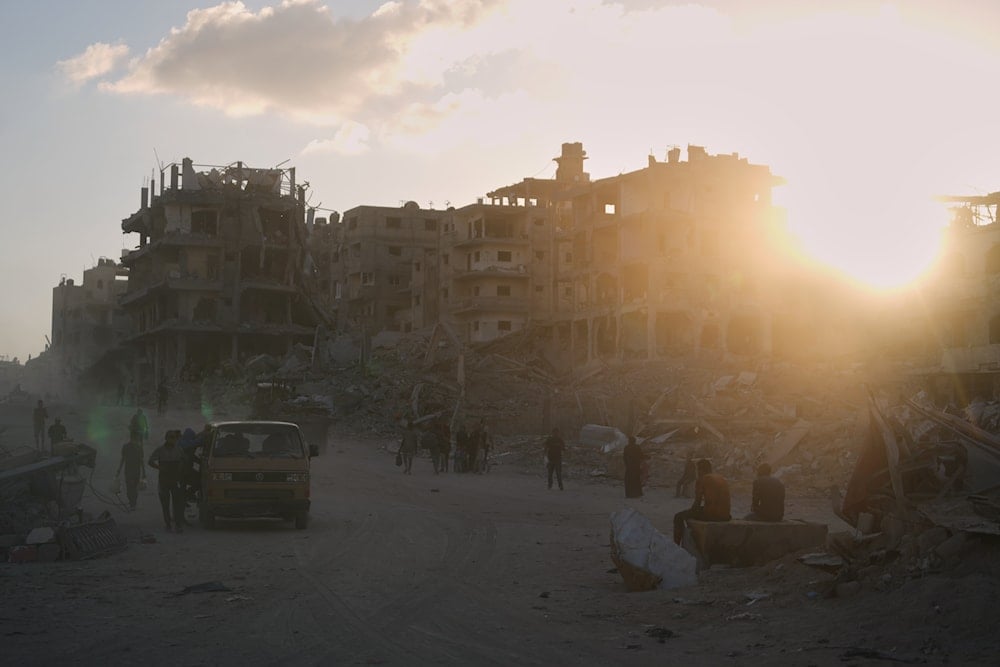Prisoner exchange begins in first leg of Gaza ceasefire plan
Seven Israeli captives released by the Palestinian Resistance were handed over to the Red Cross as part of the first phase of the Gaza easefire plan. Palestinian detainees are also set for release in the large-scale exchange.
-

Palestinians walk among destroyed buildings in Gaza City, October 12, 2025. (AP Photo/Jehad Alshrafi)
Israeli media outlets reported that seven Israeli captives released by Hamas under the first phase of US President Donald Trump's ceasefire plan in the Gaza Strip have been handed over to the International Committee of the Red Cross (ICRC) and are reportedly in good condition.
Earlier this morning, the Israeli army stated that ICRC vehicles arrived at an agreed-upon location in the northern Gaza Strip to receive the released captives. This development comes after days of ongoing negotiations mediated by Egypt, Qatar, and the United States.
Moreover, Red Cross buses also headed to Gaza's Khan Younis to receive the second batch of Israeli captives.
The Israeli army confirmed its readiness to receive the additional captives, stating that more captives were expected to be transferred to the Red Cross later in the day.
According to Channel 13, the prisoner handover was scheduled to begin at 8 am in the Netzarim area, followed by another transfer at 10 am in Khan Younis. The process is being carried out under international supervision.
Palestinian detainees prepare for release
On the Palestinian side, buses departed from Gaza toward the Karem Abu Salem crossing in preparation for receiving the Palestinian detainees scheduled for release.
According to Al Mayadeen’s correspondent in Gaza, the families of the detainees have not yet been informed of the official list of those being freed or whether any will be deported. Meanwhile, the al-Qassam Brigades released the names of the living Israeli captives expected to be released.
Israeli media reported that buses carrying Palestinian detainees arrived at Ofer Prison early in the morning, and sources confirmed that final preparations have been completed for the release of more than 2,000 Palestinian detainees as part of the agreement’s first phase.
Shosh Bedrosian, spokesperson for Israeli Prime Minister Benjamin Netanyahu, stated that the government expects all 20 living captives to be released at once and handed over to the Red Cross simultaneously. On the fourth day of the ceasefire, Netanyahu described the return of the captives as a “historic event” marked by a mixture of "sadness and joy."
Israeli authorities also acknowledged that the bodies of some deceased captives may not be recovered. In such cases, an international body designated under Trump’s ceasefire plan is expected to assist in locating and retrieving the remains.
Gaza ceasefire
Speaking to Israeli Channel 12, Trump described the Gaza agreement as "his greatest political achievement." The White House confirmed it continues to oversee implementation of the first phase, which includes:
- A full ceasefire
- The withdrawal of Israeli occupation forces
- The gradual release of prisoners on both sides
The deal marks a major turning point in the war on Gaza, with eyes now on whether all phases of the agreement will proceed smoothly in the coming days.
On October 9, Khalil al-Hayya, the head of Hamas in Gaza and the chief Palestinian negotiator, announced that an agreement had been reached to end the war and aggression against the Palestinian people, after two years of a brutal and ceaseless war that killed over 67,000 Palestinians.
Al-Hayya explained that the movement received guarantees from the mediators and the US administration, and he confirmed that all parties stressed that the war has ended completely.
Additionally, he revealed that the agreement includes the release of 250 prisoners serving life sentences, and 1700 detainees from Gaza who were arrested after October 7th, as well as the release of all women and children.

 4 Min Read
4 Min Read









